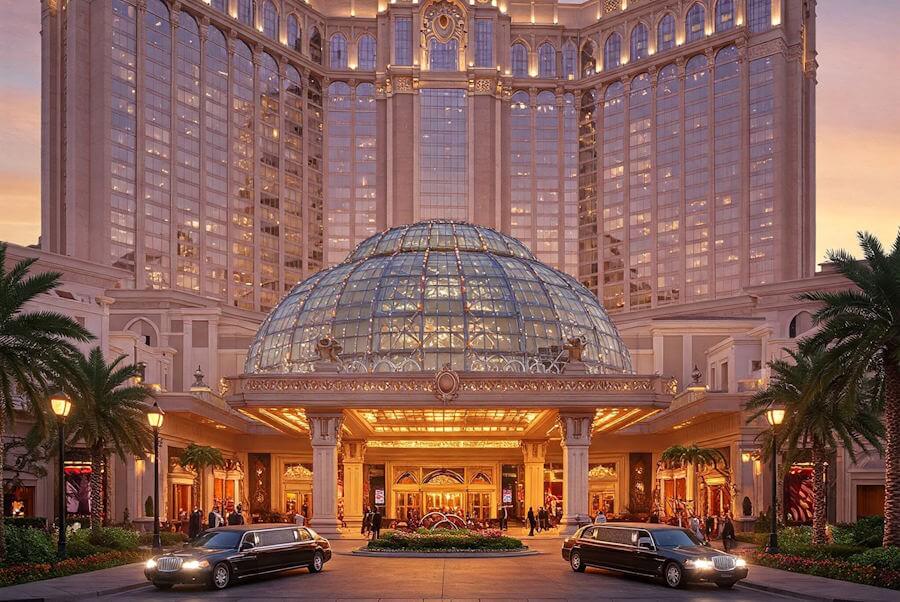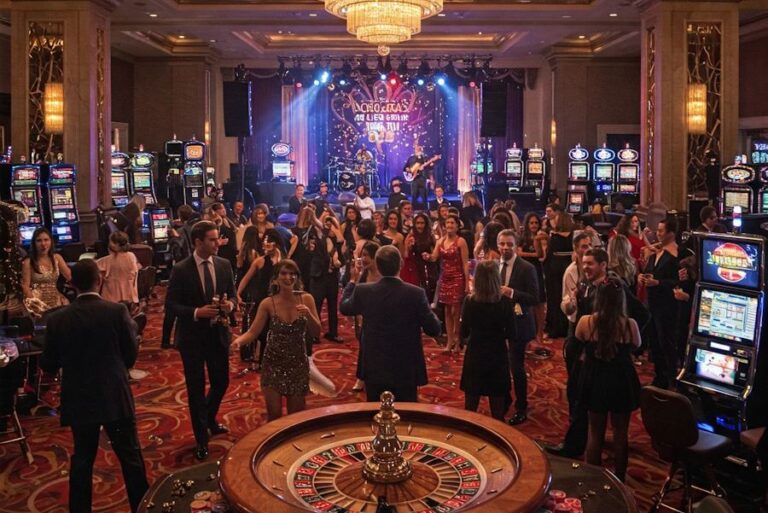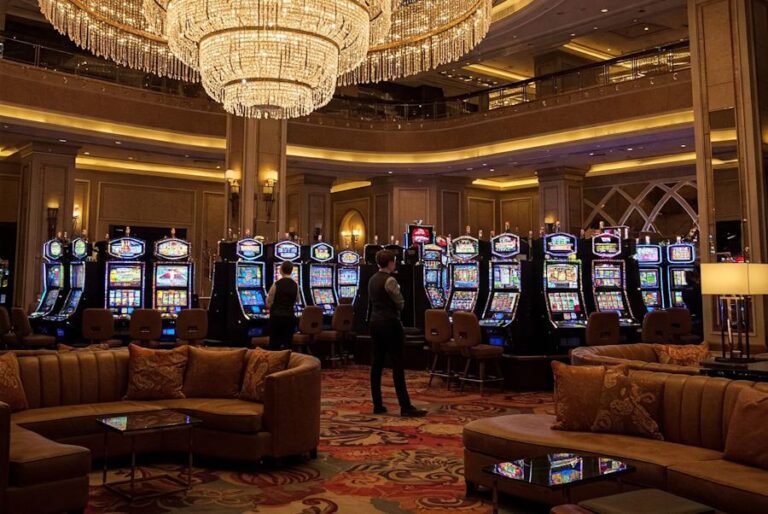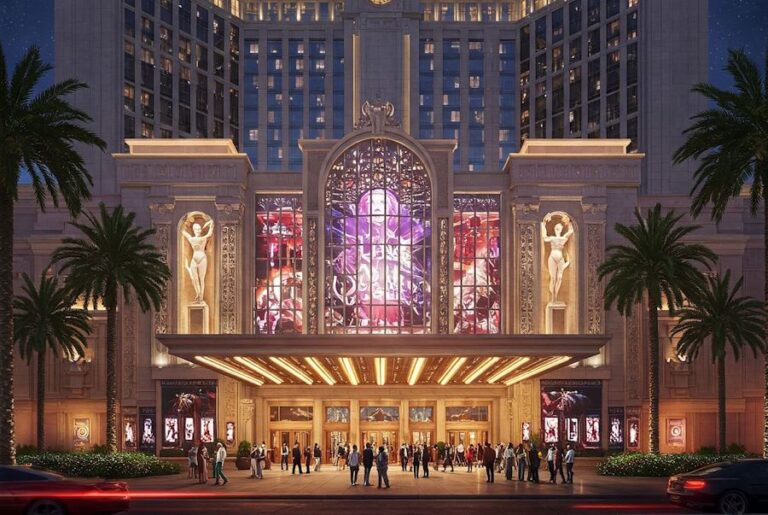Top Casino Hotels with Breathtaking Architecture
Casino hotels represent a unique synthesis of luxury accommodation and dynamic entertainment, which has made them a popular choice for travelers seeking both relaxation and excitement. These establishments not only provide comfortable lodging but also feature vast gaming areas, restaurants, and a plethora of recreational activities. This dual-purpose functionality is essential to their appeal, offering guests a comprehensive experience under one roof.
The architectural design of casino hotels plays a pivotal role in attracting visitors, as it sets the tone for what can be expected throughout the stay. Stunning structures characterized by striking facades and opulent interiors enhance the overall atmosphere, enticing guests to explore the various amenities. The visual appeal of these establishments often mirrors the vibrant and exhilarating environment that one associates with the casino experience. For instance, intricate designs, grand entrances, and luxurious furnishings are commonly used to evoke feelings of elegance and indulgence.
Moreover, the integration of architectural elements that reflect local culture or innovative trends can significantly enhance the guest experience. Unique designs can serve as landmarks in themselves, often becoming a point of interest or conversation among guests. This is particularly relevant in destinations where casino hotels are prevalent, as they compete not only with one another but also with surrounding attractions for the attention of potential visitors.
Additionally, the ambiance created by exceptional architecture contributes to the excitement associated with gambling and entertainment within these venues. Illuminated spaces and thoughtfully arranged layouts guide patrons seamlessly from gaming tables to fine dining options, all while maintaining an aesthetic that inspires awe and wonder. As the competition in the hospitality industry intensifies, the importance of striking architecture in casino hotels continues to grow, positioning them as significant players in the tourism sector.
The Importance of Architecture in Casino Hotels
The architecture of casino hotels plays a pivotal role in enhancing the overall guest experience. Unique and innovative designs serve not only as eye-catching elements but also create an ambiance that fosters excitement and luxury. When a visitor steps into a casino hotel, the architectural style sets the tone for their stay, evoking emotions and anticipation as they navigate through the space. Each aspect of design, from the grand entrances to the intricate details in the interior décor, contributes to a memorable experience.
Modern casino hotels often incorporate architectural trends that reflect their geographical location, cultural heritage, and the theme of the establishment. For example, many Las Vegas hotels showcase opulent designs inspired by classical art and European palaces, creating a sense of grandeur. In contrast, others may adopt a contemporary style with sleek lines and minimalist aesthetics, appealing to a more modern audience. These diverse architectural styles serve not just as a backdrop for gaming and entertainment but as a defining characteristic of the venue itself.
Moreover, innovative architecture can cater to a variety of amenities beyond gaming. Casino hotels may feature luxurious spas, gourmet restaurants, and shopping areas, all integrated into the architectural design. This integration facilitates a seamless flow for guests, allowing them to explore various offerings without feeling overwhelmed. Additionally, sustainable architecture is gaining traction in the casino hotel industry, with energy-efficient designs and environmentally friendly materials being incorporated to attract ecologically conscious travelers.
Ultimately, the significance of architecture in casino hotels goes beyond mere aesthetics; it curates an experience that enhances guest satisfaction and ensures that their stay is truly unforgettable. From the initial impression to the final moment, the architectural mastery within these establishments is essential for creating lasting memories.
Top 5 Casino Hotels with Remarkable Architecture
When it comes to combining luxury, entertainment, and stunning design, the following five casino hotels exemplify remarkable architectural creativity and innovation. Each of these establishments boasts a unique style that not only enhances their visual appeal but also offers guests an unforgettable experience.
1. Bellagio Hotel and Casino – Las Vegas, Nevada
The Bellagio is renowned for its exquisite Italian Renaissance architecture, highlighted by its captivating fountains that perform choreographed shows. The hotel’s interior features a stunning gallery adorned with glass sculptures by artist Dale Chihuly, creating an atmosphere of opulence. The blend of beauty and sophistication makes it a standout in the hospitality industry.
2. Marina Bay Sands – Singapore
A modern marvel, Marina Bay Sands showcases a futuristic architectural design featuring three interconnected towers topped by a distinctive sky park. This iconic structure not only dominates the skyline but also hosts an infinity pool that offers breathtaking views of the city. The seamless integration of luxury and technology has allowed it to receive numerous accolades.
3. Palazzo Resort Hotel Casino – Las Vegas, Nevada
The Palazzo is an architectural homage to Venice, featuring grand Italianate designs and expansive murals. This casino hotel is well-known for its elegant columns, mosaic-tiled floors, and lavish public spaces reminiscent of the Venetian canals. The attention to detail emphasizes the resort’s commitment to providing a lavish experience for its guests.
4. Wynn Las Vegas – Las Vegas, Nevada
Designed by acclaimed architect Steve Wynn, this hotel combines modern architecture with environmental sustainability. The building’s distinctive curved façade and lush landscaping create an inviting atmosphere. Inside, guests can explore opulent ballrooms and a meticulously designed casino, which showcases both luxury and comfort.
5. The Cosmopolitan of Las Vegas – Las Vegas, Nevada
This hotel and casino is characterized by its contemporary design, featuring multiple outdoor terraces with unparalleled views of the Strip. The Cosmopolitan combines sleek lines with vibrant art installations, creating a modern yet welcoming environment. Its unique blend of luxury amenities and artistic flair attracts a diverse clientele seeking exceptional experiences.
These five casino hotels not only provide thrilling gambling experiences but also stand out for their remarkable architectural designs. Each building tells a story through its structure and aesthetic, ensuring that guests are immersed in a unique ambiance throughout their stay.
Las Vegas: The Architectural Marvels
Las Vegas has long been celebrated as a hub for stunning casino hotels that serve as both entertainment venues and architectural masterpieces. With its distinctive skyline adorned with a mix of opulent resorts and thematic designs, the city captures the imagination of visitors worldwide. The iconic Las Vegas Strip is home to some of the most extravagant structures that not only represent the city’s vibrant culture but also embody the lavish lifestyle associated with gambling and entertainment.
One of the most famous examples is the Bellagio Hotel and Casino, renowned for its elegant Italianate architecture complemented by a stunning fountain show. Designed to evoke the charm of a European village, the hotel features a conservatory and botanical gardens that change with the seasons, offering guests a harmonious blend of nature and luxury. The grandeur of the Bellagio is matched by the nearby Venetian Resort, which transports visitors to Italy with its canals, gondolas, and replicas of historical landmarks. The resort employs an imaginative design philosophy, encapsulating the essence of Venice while providing a unique gambling experience for its patrons.
Another architectural marvel is the Luxor Hotel, distinguished by its massive pyramid shape. Symbolizing ancient Egypt, this structure stands out on the Strip and houses a blend of sophisticated designs and modern amenities. The Luxor’s uniquely themed casino and entertainment options attract visitors, while the striking exterior has made it a recognizable landmark. The Wynn and Encore resorts also contribute to the architectural splendor of Las Vegas, showcasing contemporary designs intertwined with eco-friendly elements. With their sleek lines and lavish interiors, they reflect the city’s continuous evolution toward sophistication and sustainability.
These unique designs not only enhance the visual allure of Las Vegas but also create immersive experiences for visitors, making them more than just places to gamble. The architectural feats of Las Vegas symbolize a synergy between art, culture, and entertainment, captivating all who venture into this remarkable city.
International Gems: Casino Hotels Around the World
While Las Vegas is often considered the epicenter of casino hotels, numerous remarkable establishments worldwide showcase breathtaking architecture that reflects their cultural heritage and local environments. From the opulent designs in Asia to the historical grandeur in Europe, these casinos have become iconic structures embodying the essence of their respective regions.
In Asia, one of the most striking examples is the Marina Bay Sands in Singapore. This architectural marvel features three interconnected towers topped by a unique sky park, offering sweeping views of the city skyline. The design is not only visually stunning but also incorporates sustainable features, showcasing a commitment to modern design that respects ecological principles. Adjacent to the hotel, the Gardens by the Bay seamlessly integrates nature into urban life, further enhancing its appeal as a destination.
Traveling to Europe, the Casino de Monte-Carlo in Monaco stands out with its lavish Belle Époque architecture. Opening its doors in 1863, this historic casino boasts a grand entrance adorned with intricate sculptures and an elegant façade. The building’s interior is equally impressive, decorated with opulent chandeliers and rich fabrics, truly reflecting the glamour of the region. Additionally, the casino’s location allows for breathtaking views of the Mediterranean, making it a perfect blend of architecture and nature.
Beyond these examples, the iconic Foxwoods Resort Casino in Connecticut, USA, shows how cultural elements can adapt contemporary designs. Its interiors echo Native American heritage, showcasing artwork and motifs that celebrate the region’s history. As one of the largest casinos in the world, it proves that modern casino hotels can also honor cultural narratives through their architectural choices.
These international gems demonstrate that breathtaking architecture is not confined to one continent. Rather, across the globe, casino hotels encapsulate their local cultures while providing stunning visual experiences that attract visitors from all walks of life.
Innovative Sustainability in Casino Hotel Design
The intersection of luxury and sustainability has become a focal point in the development of modern casino hotels. In an era where environmental awareness has surged, many establishments are prioritizing eco-friendly architecture as a core element of their design philosophy. This approach incorporates various innovative methods aimed at maximizing energy efficiency and minimizing environmental impact while maintaining a sense of opulence.
One notable feature that has gained traction in the design of these establishments is the use of sustainable materials. Many casino hotels are opting for locally sourced, recycled, or biodegradable materials in their construction processes. This not only supports local economies but also reduces the carbon footprint associated with transportation and production. Furthermore, these materials often enhance the aesthetic appeal of buildings, blending seamlessly with luxurious design elements.
Additionally, energy-efficient technologies are increasingly integrated into casino hotel operations. These can include solar panels, energy-efficient heating and cooling systems, and advanced lighting systems that adjust based on occupancy. Such initiatives not only diminish the reliance on non-renewable energy sources but also contribute to significant operational savings over time. For instance, some hotels have implemented smart-building technologies that optimize energy consumption, ensuring that energy wastage is kept to a minimum.
Water conservation is another critical aspect of sustainable hotel design. Landscaping with drought-resistant plants, along with rainwater harvesting systems, helps in minimizing water usage, which is especially important in resource-strained areas. By incorporating these elements, casino hotels are not just enhancing their luxury quotient but are also championing environmental stewardship.
In conclusion, innovative sustainability in casino hotel design represents a forward-thinking approach that harmonizes comfort, luxury, and eco-consciousness. As more establishments adopt such practices, the industry moves closer towards a sustainable future without compromising on the experiences provided to their guests.
The Role of Art and Culture in Casino Hotel Architecture
Architectural design in casino hotels is significantly influenced by the surrounding art and culture, reflecting the region’s heritage and identity. This melding of local artistic expressions into the very fabric of these establishments not only enhances their aesthetic appeal but also enriches the visitor experience. Local artists often collaborate with architects to create spaces that resonate with both the aesthetic and cultural narratives of the area, ensuring that the architecture serves as a testament to the locale’s unique character.
For instance, casinos in Las Vegas often showcase themes derived from iconic global landmarks, which serve as a canvas for incorporating local art. The Bellagio, known for its elaborate fountain show, features artworks by renowned artists, each strategically placed throughout the hotel. The hotel’s internal design resonates with the spirit of the Italian town of Bellagio and utilizes local cultural motifs, giving guests a sense of immersion into a different cultural experience, despite the hotel’s location in the Mojave Desert.
Another exemplary model can be observed in the growth of casinos in Macau, where Portuguese and Chinese influences are seamlessly integrated. The Venetian Macao, for instance, replicates the beauty of Venice, with stunning murals and sculptures that pay homage to both local history and international art. Such artistic endeavors not only offer a visual feast but also narrate stories that captivate guests, making their stay memorable.
Furthermore, many casino hotels utilize art installations, exhibitions, and performances that reflect the artistic community of the region. These not only act as attractions but also promote local artists, fostering a sense of pride and connection between the hotel and its surroundings. This blend of art and culture within casino architecture not only enhances the visual appeal but also contributes to an enriched guest experience, fostering deeper engagement with the environment and its history.
Experiencing Architecture: Guest Perspectives
The architectural magnificence of casino hotels often leaves a lasting impression on their guests, with many sharing their enchanting experiences through testimonials and reviews. Visitors frequently express their appreciation for the grandeur and elegance of the structures, which serve not only as places of leisure but also as works of art. These sentiments reveal a strong connection between the architectural beauty of the hotels and the overall satisfaction of their stays.
Many guests remark on the intricate design details that define their experiences. For example, a visitor to a renowned casino hotel noted how the soaring ceilings and sweeping staircases made them feel as if they were stepping into a different world. Such elements create a sense of awe and wonder, often becoming a highlight of their stay. Others have pointed out how the unique blend of modern and traditional architectural styles contributes to a distinctive ambiance, making their time spent at the hotel memorable.
In addition to the aesthetics, guests often comment on how the architecture influences their interactions within the space. For instance, the thoughtful layout of the lobbies and gaming areas encourages socialization, enhancing guest engagement. One visitor shared that the open design made it easy to connect with fellow travelers, fostering a sense of community that enriched their overall experience.
Moreover, some have highlighted how the architectural features enhance their sense of comfort and relaxation. Spacious suites with stunning views or serene outdoor terraces provide a peaceful escape from the bustling casino floor. This connection between environment and experience emphasizes the importance of architecture in shaping a guest’s enjoyment.
Ultimately, the testimonials reflect a common theme: the architectural beauty of casino hotels significantly enhances the overall guest experience, establishing them as more than mere accommodations, but rather as extraordinary destinations in their own right.
Conclusion: The Future of Casino Hotel Architecture
The landscape of casino hotel architecture is on the brink of a transformative evolution. As we embrace the advancements in technology and design, it is evident that these establishments will continue to captivate visitors not only through their aesthetic appeal but also through enhanced functionality. Over the past few years, we have witnessed a growing emphasis on sustainable design practices, which not only addresses environmental concerns but also resonates with a clientele that is increasingly conscious of their ecological footprint.
Integration of smart technology is another key trend shaping the future of casino hotel architecture. From energy-efficient systems to personalized guest experiences through mobile applications, casino hotels are poised to leverage technology to create a seamless environment for their patrons. For instance, advancements in artificial intelligence and machine learning can provide custom-tailored services, allowing guests to feel more engaged and valued during their stay. As technology evolves, we can expect these architectural marvels to incorporate features such as virtual reality experiences and interactive art installations, enhancing the ambiance and entertainment value.
Furthermore, the design of casino hotels is likely to reflect a balance between luxury and comfort. Modern travelers seek not only opulence but also spaces that promote relaxation and social interaction. Future developments may likely include open-concept lounges, outdoor spaces, and community areas to foster engagement among guests, all while maintaining a breathtaking skyline view. This dual focus on functionality and aesthetic appeal will ensure that casino hotels remain destinations of choice for both leisure and business travelers alike.
In summary, the future of casino hotel architecture will be characterized by the synthesis of technology, sustainability, and exquisite design, ensuring a captivating experience for all visitors. As these trends unfold, the casino hotel sector is set to redefine its identity while remaining a focal point of architectural innovation.







